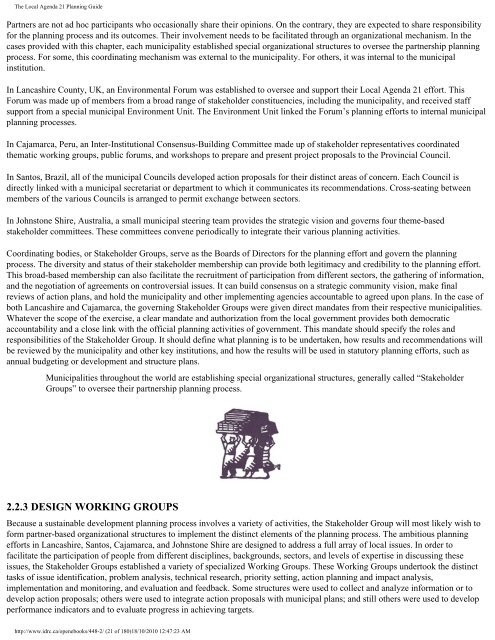The Local Agenda 21 Planning Guide - Democrats Against UN ...
The Local Agenda 21 Planning Guide - Democrats Against UN ...
The Local Agenda 21 Planning Guide - Democrats Against UN ...
You also want an ePaper? Increase the reach of your titles
YUMPU automatically turns print PDFs into web optimized ePapers that Google loves.
<strong>The</strong> <strong>Local</strong> <strong>Agenda</strong> <strong>21</strong> <strong>Planning</strong> <strong>Guide</strong><br />
Partners are not ad hoc participants who occasionally share their opinions. On the contrary, they are expected to share responsibility<br />
for the planning process and its outcomes. <strong>The</strong>ir involvement needs to be facilitated through an organizational mechanism. In the<br />
cases provided with this chapter, each municipality established special organizational structures to oversee the partnership planning<br />
process. For some, this coordinating mechanism was external to the municipality. For others, it was internal to the municipal<br />
institution.<br />
In Lancashire County, UK, an Environmental Forum was established to oversee and support their <strong>Local</strong> <strong>Agenda</strong> <strong>21</strong> effort. This<br />
Forum was made up of members from a broad range of stakeholder constituencies, including the municipality, and received staff<br />
support from a special municipal Environment Unit. <strong>The</strong> Environment Unit linked the Forum’s planning efforts to internal municipal<br />
planning processes.<br />
In Cajamarca, Peru, an Inter-Institutional Consensus-Building Committee made up of stakeholder representatives coordinated<br />
thematic working groups, public forums, and workshops to prepare and present project proposals to the Provincial Council.<br />
In Santos, Brazil, all of the municipal Councils developed action proposals for their distinct areas of concern. Each Council is<br />
directly linked with a municipal secretariat or department to which it communicates its recommendations. Cross-seating between<br />
members of the various Councils is arranged to permit exchange between sectors.<br />
In Johnstone Shire, Australia, a small municipal steering team provides the strategic vision and governs four theme-based<br />
stakeholder committees. <strong>The</strong>se committees convene periodically to integrate their various planning activities.<br />
Coordinating bodies, or Stakeholder Groups, serve as the Boards of Directors for the planning effort and govern the planning<br />
process. <strong>The</strong> diversity and status of their stakeholder membership can provide both legitimacy and credibility to the planning effort.<br />
This broad-based membership can also facilitate the recruitment of participation from different sectors, the gathering of information,<br />
and the negotiation of agreements on controversial issues. It can build consensus on a strategic community vision, make final<br />
reviews of action plans, and hold the municipality and other implementing agencies accountable to agreed upon plans. In the case of<br />
both Lancashire and Cajamarca, the governing Stakeholder Groups were given direct mandates from their respective municipalities.<br />
Whatever the scope of the exercise, a clear mandate and authorization from the local government provides both democratic<br />
accountability and a close link with the official planning activities of government. This mandate should specify the roles and<br />
responsibilities of the Stakeholder Group. It should define what planning is to be undertaken, how results and recommendations will<br />
be reviewed by the municipality and other key institutions, and how the results will be used in statutory planning efforts, such as<br />
annual budgeting or development and structure plans.<br />
Municipalities throughout the world are establishing special organizational structures, generally called “Stakeholder<br />
Groups” to oversee their partnership planning process.<br />
2.2.3 DESIGN WORKING GROUPS<br />
Because a sustainable development planning process involves a variety of activities, the Stakeholder Group will most likely wish to<br />
form partner-based organizational structures to implement the distinct elements of the planning process. <strong>The</strong> ambitious planning<br />
efforts in Lancashire, Santos, Cajamarca, and Johnstone Shire are designed to address a full array of local issues. In order to<br />
facilitate the participation of people from different disciplines, backgrounds, sectors, and levels of expertise in discussing these<br />
issues, the Stakeholder Groups established a variety of specialized Working Groups. <strong>The</strong>se Working Groups undertook the distinct<br />
tasks of issue identification, problem analysis, technical research, priority setting, action planning and impact analysis,<br />
implementation and monitoring, and evaluation and feedback. Some structures were used to collect and analyze information or to<br />
develop action proposals; others were used to integrate action proposals with municipal plans; and still others were used to develop<br />
performance indicators and to evaluate progress in achieving targets.<br />
http://www.idrc.ca/openebooks/448-2/ (<strong>21</strong> of 180)18/10/2010 12:47:23 AM










